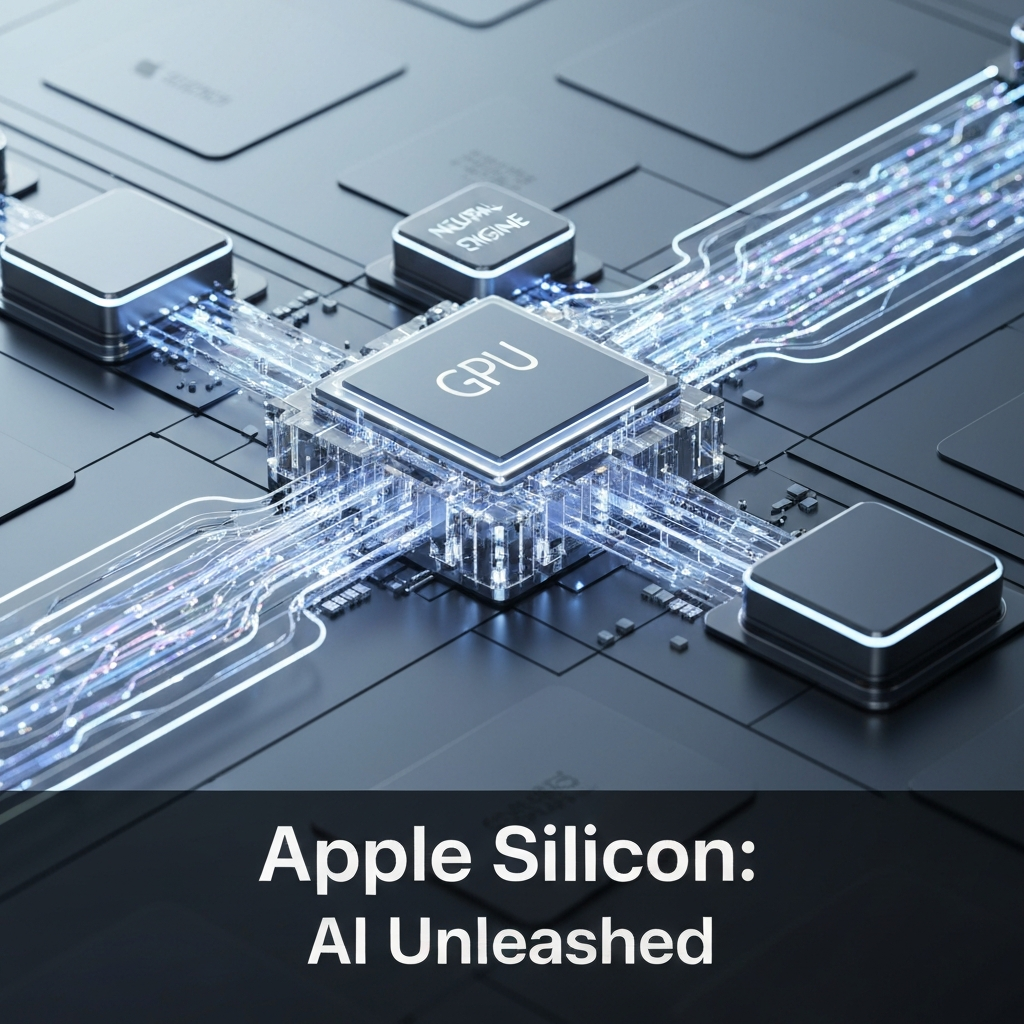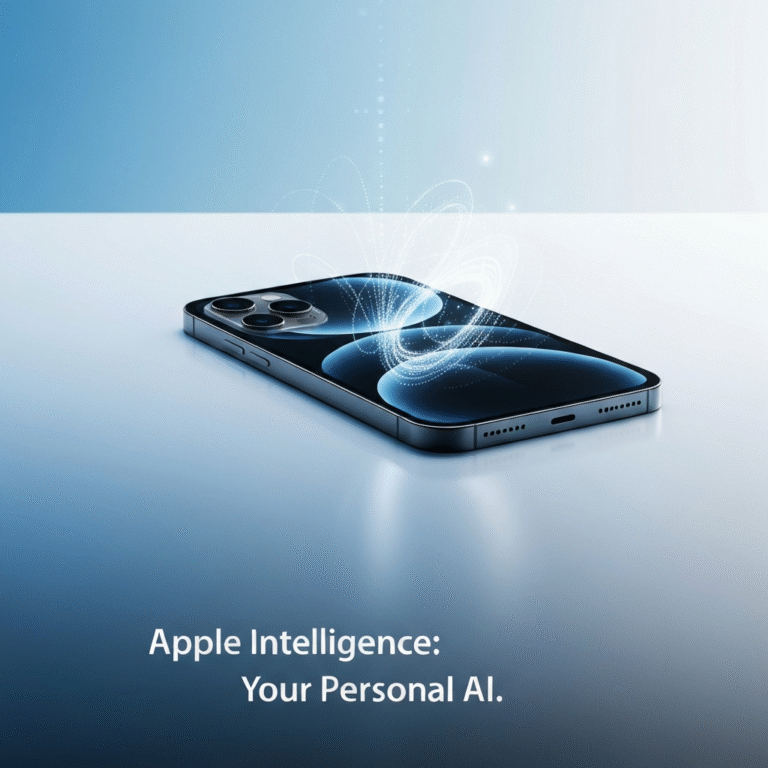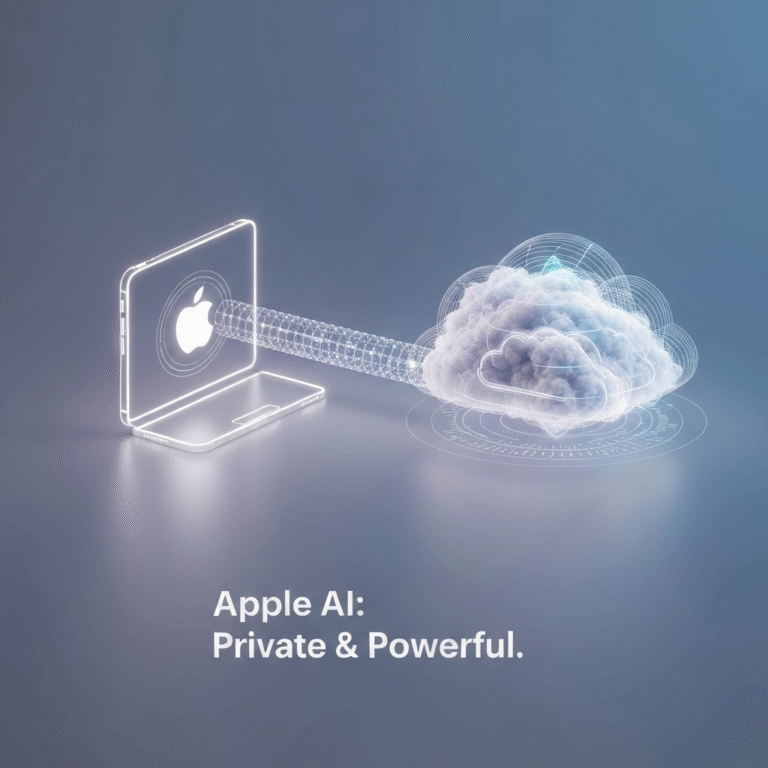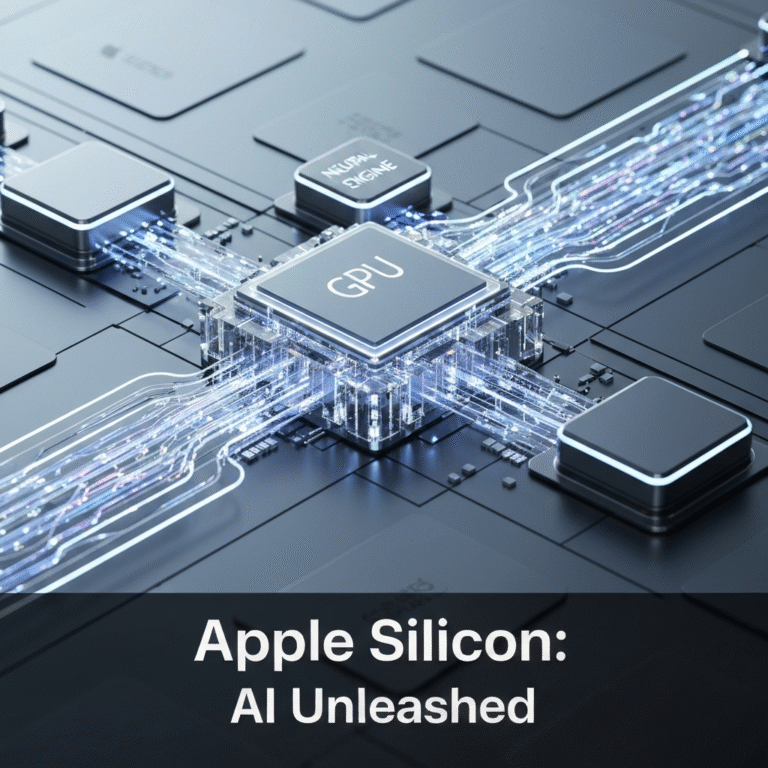
While the world buzzes about the capabilities of Apple Intelligence, the more pressing question for developers, engineers, and prosumers isn't what it does, but how it performs so seamlessly. The answer isn't found in software alone, but etched in silicon. Competitors offer vague promises or focus on raw GPU power, but Apple's true advantage lies in a fundamentally different hardware philosophy. Our winning angle is to provide the definitive technical deep dive into this edge, meticulously dissecting the architectural advantages of the Apple Neural Engine and Unified Memory. We will offer clear, data-driven comparisons to NVIDIA GPUs, precisely outlining where Apple Silicon excels in on-device inference and power efficiency, and where traditional GPUs still lead in raw training compute, giving you an authoritative, nuanced perspective on the future of AI hardware.
An Architectural Deep Dive into Apple Silicon's AI Performance
At the heart of Apple's AI prowess isn't just software, but a deeply integrated hardware philosophy. Unlike traditional PC architectures that treat components as separate, powerful islands, Apple Silicon is a System on a Chip (SoC) where the CPU, GPU, and, most importantly, the Neural Engine share a common pool of high-speed memory. This foundational design choice eliminates performance bottlenecks and unlocks efficiencies that are critical for demanding AI workloads.
The Core of the Edge: Neural Engine Architecture & Acceleration
The Apple Neural Engine (ANE) is not a general-purpose processor; it's a highly specialized piece of silicon known as a Neural Processing Unit (NPU). The Apple Neural Engine (ANE) is a specialized processor dedicated to accelerating AI and ML workloads by performing specific, high-volume mathematical operations efficiently, including matrix multiplications and convolutions.
While a high-end GPU can perform trillions of calculations per second, it does so with a significant power and thermal cost. The ANE, by contrast, is designed for efficiency. This is the fundamental difference in the NPU vs GPU debate for on-device AI. The ANE provides dedicated Apple Neural Engine acceleration for tasks like facial recognition, natural language processing, and computational photography, offloading them from the CPU and GPU. This frees up those resources for other tasks, resulting in a system that feels faster and more responsive, even while performing complex AI computations in the background.
How Unified Memory Delivers Unprecedented AI Benefits
Perhaps the most significant architectural advantage Apple Silicon holds is its Unified Memory Architecture (UMA). In a traditional system with a discrete NVIDIA GPU, data must be copied from the system RAM over a PCIe bus to the GPU's dedicated VRAM. This process introduces latency and is a major bottleneck for AI models that require massive datasets.
UMA completely changes the game. With Apple's approach, a single pool of high-bandwidth, low-latency memory is accessible to the CPU, GPU, and Neural Engine simultaneously. There is no data duplication or copying. This provides immense Unified Memory AI benefits:
* Massive Memory Pools: AI developers can leverage the entire system memory—up to 192GB on a Mac Studio—for their models, a feat impossible on most consumer GPUs, where even high-end models like the NVIDIA GeForce RTX 4090 top out at 24GB of VRAM.
* Reduced Latency: Apple Silicon's Unified Memory Architecture (UMA) eliminates data transfer bottlenecks, providing high memory bandwidth and reducing latency, which significantly accelerates AI training and inference speeds on large models.
* Enhanced Efficiency: Less data movement means lower power consumption, contributing to the platform's overall performance-per-watt advantage.
Benchmarking the Beast: Apple Silicon NPU Performance
While Apple is often tight-lipped about raw TOPS (trillions of operations per second) figures, real-world benchmarks consistently demonstrate the formidable Apple Silicon NPU performance. Analysis from reputable third-party benchmark sites like AnandTech often attempts to measure or analyze NPU performance to provide external validation. In power-constrained mobile environments, the Apple Neural Engine (ANE) with Core ML is generally considered to be among the most power-efficient solutions for on-device AI inference, often outperforming competitors like Google Tensor's TPU in performance per watt, as shown in Geekbench ML tests.
Looking ahead, expectations are high for future iterations like the M5 chip. As developers continue to optimize for this architecture, we anticipate M5 chip AI benchmarks will further challenge the norms of high performance computing, especially in creative and development fields where on-device processing is paramount.
Comparative Analysis: Apple Silicon vs. NVIDIA for AI Workloads
The choice between Apple Silicon and an NVIDIA-powered system depends entirely on the specific AI workload. It's not a question of which is "better," but which is the right tool for the job.
Head-to-Head: Apple Silicon vs. NVIDIA for AI Tasks
The Apple Silicon vs NVIDIA AI debate centers on specialization. This computer comparison reveals a clear divergence: Apple is optimizing for the "edge" and personal AI, while NVIDIA continues to power the massive cloud infrastructure where models are born.
Is a Mac the Right Choice for LLM & ML Workloads?
For a growing number of developers and researchers, the answer is yes. The Mac Studio LLM performance, in particular, has become a benchmark for local AI development. The ability to load a 70-billion parameter model into memory for testing and fine-tuning is a capability that, until recently, was reserved for servers.
This makes Apple Silicon for machine learning an incredibly attractive proposition for tasks like model quantization, inference optimization, and application development. For those wondering about the best Apple devices for AI development, the Mac Studio and MacBook Pro models with M-series Pro, Max, or Ultra chips offer the best balance of performance and memory capacity.
The New Paradigm: On-Device vs. Cloud AI on Apple Hardware
Apple's entire strategy hinges on championing on-device processing. The debate of on-device AI vs cloud AI Apple is central to their user privacy and performance narrative. By processing data directly on the iPhone, iPad, or Mac, Apple Intelligence can offer highly personalized, context-aware assistance without sending sensitive information to the cloud.
This requires sophisticated workload management tools built into the operating system, which can seamlessly decide whether a task is simple enough for the Neural Engine or requires the "Private Cloud Compute" for more complex queries, always prioritizing user privacy.
Real-World Applications, Limitations, and the Future
The architectural advantages of Apple Silicon are not just theoretical; they directly enable the next generation of AI-powered user experiences while also presenting a new set of considerations for developers.
Powering the Experience: Apple Intelligence Performance Benefits
The primary beneficiary of the Neural Engine and Unified Memory is Apple's own suite of AI features. The Apple Intelligence performance benefits are evident across the OS. Features like semantic search in Photos, contextual awareness in Siri, and on-the-fly text generation are executed instantly and privately on the device. This deep hardware and software integration is what allows Apple to deploy features that feel both powerful and secure. For users wanting a broader understanding of these features, our complete guide to Apple Intelligence offers a comprehensive overview. The performance of these tools on the latest hardware, like the upcoming iPhone 16, is a direct result of the NPU's efficiency.
Running Local LLMs and AI Media Applications on Mac
Beyond Apple's ecosystem, the professional community is leveraging this power for remarkable applications. The ability to run a local LLM on Mac has empowered developers to build and test AI applications without relying on costly cloud APIs.
In the creative space, AI video enhancement Apple Silicon performance is a standout example. Applications like Final Cut Pro use the Neural Engine to accelerate object tracking and scene detection, while third-party tools leverage Core ML performance M5 (and its predecessors) for advanced upscaling and noise reduction. This brings workstation-class AI media processing to a portable and silent form factor.
Acknowledging the Boundaries: Apple Silicon's Current AI Limitations
Despite its strengths, it's crucial to recognize the Apple Silicon AI limitations.
1. Raw Compute Ceiling: A single Mac Studio, while powerful, cannot compete with a multi-GPU server running several NVIDIA H100s for training massive, foundational models. The architecture is not designed for distributed, large-scale training.
2. Software and Tooling: While improving rapidly, the software ecosystem for high-end AI research on Apple Silicon is less mature than NVIDIA's CUDA. Some frameworks and pre-trained models are still optimized primarily for NVIDIA hardware, requiring developers to perform additional conversion or optimization steps.
3. GPU Architecture: While the GPU in Apple Silicon is powerful for graphics and certain compute tasks, it is not as flexible or programmable for general-purpose scientific computing as NVIDIA's offerings, which have been honed for that market for over a decade.
---
About the Author
Hussam Muhammad Kazim is an AI Automation Engineer with 3 months of experience, specializing in the practical application and performance analysis of emerging AI hardware architectures.
Frequently Asked Questions
What is the Apple Neural Engine?
The Apple Neural Engine (ANE) is a specialized processor, also known as a Neural Processing Unit (NPU), integrated into Apple Silicon chips. Its specific purpose is to accelerate the mathematical operations used in artificial intelligence and machine learning algorithms, allowing for high-speed, power-efficient execution of tasks like image recognition and natural language processing directly on the device.
Is Apple Silicon better than NVIDIA for AI?
Neither is definitively 'better'; they are designed for different tasks. Apple Silicon excels at power-efficient, on-device AI inference and running large models locally thanks to its Unified Memory. NVIDIA GPUs are the industry standard for large-scale AI model training in data centers due to their raw computational power and mature CUDA software ecosystem.
Can you run large language models (LLMs) on a Mac?
Yes. Thanks to Apple's Unified Memory Architecture, Macs (especially Mac Studio and MacBook Pro models with M-series Max or Ultra chips) can be configured with up to 192GB of memory. This allows them to run very large language models locally for development, testing, and inference—a task that would require expensive, specialized NVIDIA data center GPUs.
What are the main limitations of Apple Silicon for AI development?
The primary limitations are a lower raw compute ceiling compared to multi-GPU NVIDIA servers (making it less suitable for training foundational models from scratch), a software ecosystem that is still maturing compared to NVIDIA's CUDA platform, and a GPU architecture less optimized for general-purpose scientific computing.




